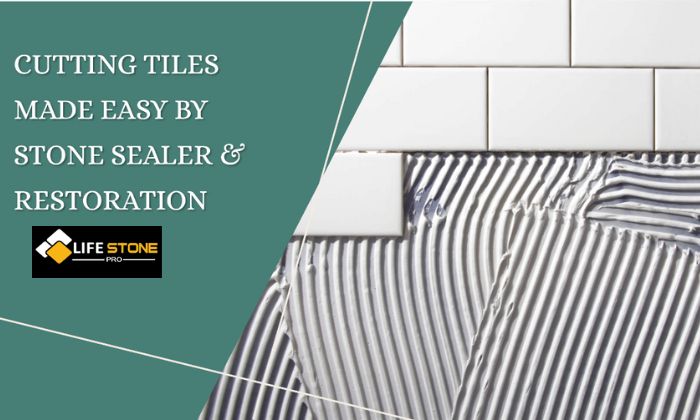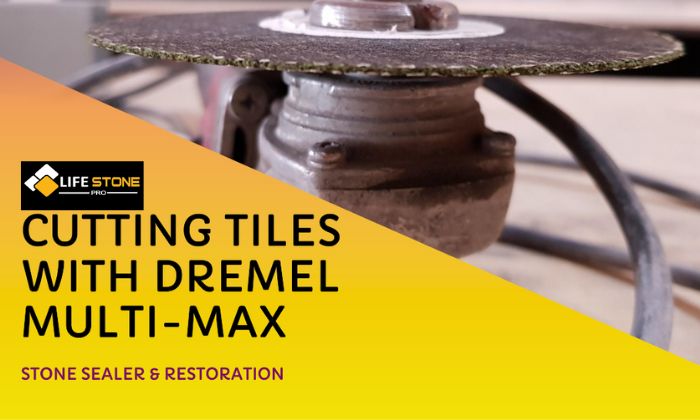Cutting Tile with Dremel: Mastering the Art by Stone Sealer
Cutting tile is an essential part of various home improvement projects, from tiling a bathroom floor to creating intricate mosaic designs. While there are numerous tools available for this purpose, one versatile and precise option is using a Dremel rotary tool.
In this article, we’ll explore how to cut tile with a Dremel, specifically highlighting the use of Dremel Multi-Max, Dremel diamond wheels, and other Dremel tools for this purpose, with a focus on Stone Sealer and Restoration as a trusted brand for Dremel accessories.

Why Use a Dremel for Cutting Tile
Dremel rotary tools have gained immense popularity for their versatility and precision in various DIY tasks. When it comes to cutting tile, Dremel tools offer several advantages:
Precision and Accuracy
Dremel rotary tools have earned their place as a top choice for cutting tile due to their ability to deliver precision and accuracy in every cut. Whether you’re working on a delicate mosaic or a large flooring project, a Dremel ensures that you make clean and precise cuts with ease.
Versatility for Varied Projects
One of the key advantages of using a Dremel for tile cutting is its remarkable versatility. These tools are not limited to a single type of tile or project. From ceramics to glass and even stone tiles, a Dremel can handle a wide range of tile materials with finesse.
Control over Cutting Speed
Dremel rotary tools offer the crucial advantage of control over cutting speed, especially when dealing with delicate tasks like cutting tile around a toilet. This control allows users to adapt the tool’s speed to the specific tile type and thickness, ensuring that each cut is clean and precise. By doing so, you can prevent any accidental chipping or damage, maintaining the integrity of your tile installation.
Portability and Ease of Use
Dremel tools are known for their portability and user-friendliness. Their lightweight and ergonomic design make them ideal for both small DIY projects and larger, professional endeavors. You can take your Dremel wherever your project demands without experiencing fatigue or discomfort.
Adaptable to Both Novices and Experts
Dremel’s ease of use is an appealing feature, making it accessible to both novices and experienced DIY enthusiasts. Whether you’re just starting with tile cutting or you’re a seasoned pro, a Dremel is a versatile tool that can cater to your skill level, providing consistent, high-quality results.
Choosing the Right Dremel for the Job
Selecting the right Dremel tool is crucial for successful tile cutting. Consider the following factors when choosing your Dremel:
Selecting the Ideal Dremel Model
The first step in choosing the right Dremel for your project involves selecting the most suitable model for the job. Dremel offers a range of rotary tools and oscillating tools, each designed for specific applications. Determine which model best aligns with your intended use.
Equipping the Right Accessories
Once you’ve chosen the appropriate Dremel model, it’s essential to equip it with the right accessories for your project. Dremel provides a plethora of attachments and add-ons, including cutting wheels, sanding disks, and engraving bits. Ensure you have the necessary accessories to accomplish your task efficiently.
Matching Power and Speed
Matching the Dremel’s power and speed to your project’s requirements is crucial for a successful outcome. Consider the hardness and thickness of the tile you’re cutting. For harder materials, you may need a Dremel with higher power and lower speed settings, while softer materials can be tackled with lower power and higher speeds.
Prioritizing Ergonomics and Comfort
Ergonomics play a significant role in the comfort and efficiency of your work. Choose a Dremel tool with an ergonomic design that fits comfortably in your hand. A comfortable grip reduces hand fatigue, allowing you to work for longer periods without discomfort.
Considering Your Skill Level
Lastly, consider your own skill level when choosing the right Dremel for the job. Some Dremel models are more user-friendly and forgiving for beginners, while others offer advanced features suited for experienced users. Select a tool that matches your level of expertise to ensure a smooth and successful experience with your project.
Cutting Tile with Dremel Multi-Max
Dremel Multi-Max is a versatile oscillating tool that’s perfect for precise cuts in tile. To cut tile with a Dremel Multi-Max, follow these steps:

Selecting the Multi-Max Blade
The first step in cutting tile with the Dremel Multi-Max is to select the appropriate blade for the job. The Multi-Max offers various blade options, each designed for specific materials and cutting techniques. Choosing the right blade ensures a clean and precise cut.
Marking the Cut Line
Before you begin cutting, it’s essential to mark the cut line on the tile’s surface. Using a straight edge or template, draw the desired cutting line. Proper marking is crucial for accuracy and helps you maintain a straight and even cut.
Setting the Multi-Max Speed
Adjust the speed settings on the Multi-Max based on the type of tile you are working with. Harder tiles may require a lower speed setting, while softer materials can be cut at higher speeds. The correct speed setting prevents the risk of overheating or damaging the blade.
Executing the Cut
Once the Multi-Max is appropriately set up, it’s time to execute the cut. Start the tool and gently guide it along the marked cut line. Keep a steady hand, ensuring even pressure throughout the cut. The Multi-Max oscillating action helps in making precise and controlled cuts.
Ensuring Safety Measures
Prioritize safety when cutting with the Dremel Multi-Max. Put on safety glasses to shield your eyes from dust and other particles. Additionally, use a dust mask to prevent inhalation of particles generated during the cutting process. Adhering to these safety measures keeps your work environment safe and minimizes health risks.
Cutting Tile with Dremel Diamond Wheels
Dremel diamond wheels are excellent for cutting through hard tile materials like porcelain and ceramic. Here’s how to cut tile with a Dremel diamond wheel:

Choosing the Right Diamond Wheel
The first step when cutting tile with Dremel diamond wheels is selecting the appropriate diamond wheel for your specific project. Dremel offers a range of diamond wheels designed for cutting different types of tile materials. Make sure to choose a wheel that matches the hardness and thickness of your tile.
Marking the Cutting Line
Before you start cutting, it’s essential to mark the cutting line on the tile’s surface. Using a straight edge or a template, carefully mark the path you intend to cut. Proper marking ensures accuracy and helps you achieve a clean, precise cut.
Adjusting Dremel Speed
To achieve optimal results, it’s crucial to adjust your Dremel’s speed settings. The appropriate speed setting depends on the type of tile you are working with. Generally, harder tiles require lower speed settings, while softer materials can be cut at higher speeds. Correct speed settings prevent overheating and extend the life of the diamond wheel.
Beginning the Cut
Once you’ve set the Dremel to the correct speed, it’s time to begin the cut. Gently guide the Dremel equipped with the diamond wheel along the marked cutting line. Apply steady and even pressure as you work your way through the tile. Maintaining a consistent cutting speed ensures a precise and controlled cut.
Ensuring Safety Measures
Safety should always be a top priority when cutting tile with Dremel diamond wheels. Wear safety glasses to protect your eyes from debris and dust, as well as a dust mask to prevent inhaling particles generated during the cutting process. These safety measures contribute to a safe and healthy working environment.
Cutting Tile with Other Dremel Tools
Apart from the Dremel Multi-Max and diamond wheels, Dremel offers other tools and attachments for cutting tile, including rotary attachments and cutting guides.
Exploring Alternative Dremel Tools
When it comes to cutting tile, Dremel offers various alternative tools and attachments beyond the Dremel Multi-Max and diamond wheels. Each of these tools serves specific purposes in the realm of tile cutting, allowing you to choose the best option for your project.
Selecting the Appropriate Attachment
Before starting your tile-cutting project, ensure that you’ve selected the most suitable Dremel attachment. Whether it’s a rotary attachment, cutting guide, or other specialized accessory, choosing the right attachment is vital for achieving accurate and clean cuts.
Adapting to the Specific Task
Different Dremel tools cater to various tile materials and project requirements. Some may excel in intricate cuts, while others are better suited for straight lines or curves. Assess your project’s needs and select the Dremel tool that provides the necessary features and capabilities.
Utilizing Familiar Techniques
While the specific Dremel tool or attachment may differ, the fundamental techniques for cutting tile remain consistent. These techniques include marking cut lines, adjusting speed settings, executing the cut with a steady hand, and prioritizing safety measures such as wearing protective gear like safety glasses and dust masks. Regardless of the Dremel tool used, adhering to these techniques ensures successful tile cutting results.
Safety Precautions
Wearing Essential Safety Gear
One of the foremost safety precautions when working with Dremel tools is to wear the necessary safety gear. This gear is designed to protect you from potential hazards while ensuring a safe and healthy work environment.
Protective Gear for the Eyes and Respiratory System
When using Dremel tools for tile cutting, it’s imperative to shield your eyes from debris and dust. Safety glasses or goggles provide this crucial protection. Additionally, a dust mask is essential to prevent the inhalation of particles generated during the cutting process.
Maintaining Adequate Ventilation
Proper ventilation is a fundamental safety measure. Ensuring adequate airflow in your workspace prevents the accumulation of airborne dust and fumes, contributing to a cleaner and safer environment. Good ventilation also minimizes the health risks associated with inhaling dust particles.
Preventing Hearing Damage
In cases where Dremel tools produce significant noise levels, consider wearing hearing protection. Protecting your ears from prolonged exposure to loud noises ensures that you minimize the risk of hearing damage and maintain your auditory health.
Tips for Precision Cutting
Planning and Preparation
Before embarking on precision cutting with your Dremel tool, it’s essential to plan and prepare your workspace. This includes gathering the necessary tools and materials, as well as ensuring a clean and organized work environment.
Proper Marking Techniques
To achieve precision in your cuts, accurate marking is crucial. Using a straight edge, template, or measuring tools, mark the cutting lines on your tile surface. This step serves as your guide, ensuring that your cuts are straight, even, and in alignment with your project’s design.
Maintaining a Steady Hand and Controlled Movement
Precision cutting with a Dremel tool requires a steady hand and controlled movement. As you guide the tool along the marked lines, avoid sudden jerky motions. Apply even pressure to the tool, and keep a consistent cutting speed. This approach minimizes errors and enhances the accuracy of your cuts, resulting in a professional and polished outcome.
Maintenance and Care
Regular Cleaning and Inspection
Maintenance and care of your Dremel tool begins with regular cleaning and inspection. After each use, it’s essential to clean the tool and its accessories thoroughly. This process removes debris and dust that can accumulate and affect its performance.
Replacing Worn-out Accessories
To ensure the continued functionality and precision of your Dremel tool, regularly inspect the accessories. Cutting wheels, sanding attachments, and other consumables may wear out over time. Replacing these worn-out accessories is vital for maintaining the tool’s effectiveness and safety.
Proper Storage and Environment
Proper storage and environmental considerations are key to the long-term care of your Dremel tool. Store your Dremel and its accessories in a dry, dust-free environment. Protect it from moisture and extreme temperatures to prevent damage and ensure that it remains in excellent working condition for your future projects.
Stone Sealer and Restoration: Your Trusted Partner
Quality Dremel Accessories
Stone Sealer and Restoration stands as a trusted partner when it comes to obtaining high-quality Dremel accessories for your tile cutting needs. Their commitment to quality and excellence ensures that you receive accessories that enhance the performance and longevity of your Dremel tools.
Comprehensive Range of Dremel-Compatible Accessories
One of the key advantages of choosing Stone Sealer and Restoration as your partner is their comprehensive range of Dremel-compatible accessories. Whether you require diamond wheels, cutting guides, or any other accessory, you can find a wide selection that perfectly complements your Dremel tool, making it versatile and adaptable to various tile cutting tasks.
Reliability and Consistency
When you choose Stone Sealer and Restoration as your supplier of Dremel accessories, you gain the assurance of reliability and consistency. Their products are designed to deliver dependable performance and durability, ensuring that you can rely on your Dremel accessories to consistently meet the demands of your tile cutting projects.
Conclusion
Cutting tile with a Dremel is an excellent choice for achieving precise and intricate cuts. Whether you choose the Dremel Multi-Max, diamond wheels, or other Dremel tools, following the proper techniques and safety precautions will help you achieve professional results.
Remember to choose the right Dremel model and accessories for your specific tiling project, and consider trusted brands like Stone Sealer and Restoration for reliable Dremel accessories. With the right tools and knowledge, you can tackle any tile cutting task with confidence. If you have any questions or need assistance, please feel free to contact us for guidance.
FAQs
Can I Cut Any Type Of Tile With A Dremel?
Yes, a Dremel can cut through a wide range of tile materials, including ceramic, porcelain, and glass. The choice of Dremel model and accessories depends on the tile’s hardness.
Do I Need Any Special Safety Gear When Cutting Tiles With A Dremel?
Yes, safety gear is essential. Wear safety glasses, a dust mask, and, if necessary, hearing protection. Adequate ventilation in the workspace is also important to prevent inhaling dust particles.
Can I Cut Curved Shapes In Tile With A Dremel?
Yes, a Dremel can cut curved shapes in tile. Practice on scrap tiles to get a feel for the tool’s maneuverability, and use a steady hand to guide the Dremel along the desired curve.
How Do I Choose The Right Dremel Accessory For Cutting Tile?
The choice of Dremel accessory depends on the type of tile and the specific project. Diamond wheels are excellent for hard tiles, while Dremel Multi-Max is versatile for various tile materials.
Is It Necessary To Maintain And Clean My Dremel And Accessories?
Yes, proper maintenance is crucial for the longevity and performance of your Dremel tool and accessories. Regularly clean your Dremel, replace worn-out accessories, and store them in a dry, dust-free environment to ensure consistent performance.
